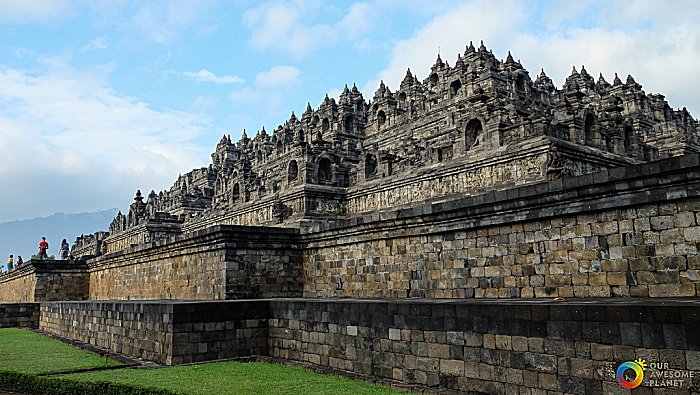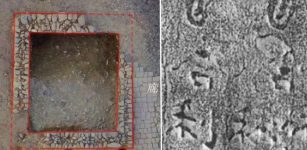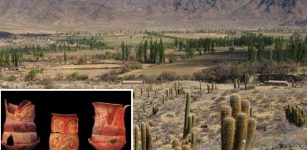World’s Largest Complex Of Borobudur – Spectacular Buddhist Masterpiece
A. Sutherland - AncientPages.com - The magnificent Borobudur is the world's largest Buddhist shrine, and one of the finest examples of eighth-century temple architecture. The Borobudur Temple, situated in central Java.
It was constructed in the 8th and 9th centuries AD during the reign of the Syailendra Dynasty, a prominent Indonesian dynasty that flourished in Java after the fall of the Funan kingdom of mainland Southeast Asia.
Aerial view of Borobudur, it took the form of a step pyramid and mandala plan. source
This architectural marvel was constructed when Buddhism and Hinduism were still the dominant religion in the region. Later, the temple was several times buried due to powerful volcanic eruptions. It remained abandoned for several hundred years before its rediscovery by the British in the 19th century.
The whole temple is in the form of a lotus, the sacred flower of Buddha. It was built in three tiers: a pyramidal base with five concentric square terraces, the trunk of a cone with three circular platforms, and at the top, a monumental stupa. The walls and balustrades are decorated with fine low reliefs, and around the circular platforms, seventy-two openwork stupas with Buddhas were constructed.
For each direction, there are 1,460 relief scenes and ninety-two Dhyani Buddha statues. (Dhyani’ is derived from the Sanskrit dhyana, meaning “meditation.” )
The monument is located in the Kedu Valley, in the southern part of Central Java, at the center of Java, Indonesia.
The structure, composed of 55,000 square meters of lava-rock is erected on a hilltop and it has a shape of a stepped pyramid of six rectangular stories, three circular terraces, and a central stupa is located at the summit.
Borobudur covers a huge area, measuring 123 x 123 meters. The perfection of this stone monument is clearly seen in its design and its decoration in the form of 2,672 carved relief panels and 504 Buddha statues.
Despite its gigantic size, historical records of its decades-long construction are sparse. The structure, built without using any kind of cement or mortar, and yet, all its parts – hold together, perfectly.
Aerial view of Borobudur. Credit: Adobe Stock - Adel
The vertical division of Borobudur Temple into base, body, and superstructure is in perfect agreement with the concept of the Universe in Buddhist cosmology - Bhumisambara, Borobudur’s original name.

Borobudur. Image credit: Anton Diaz. source
The shrine was built as a stepped pyramid. At the base of the massive temple, there are reliefs of Karmawibhangga' - depiction of human life in the endless cycle of death and rebirth (samsara) and the law of cause and effect, according to the karmic law.
See also:
8 Remarkable Jain Temples – Marvelous Ancient Architecture And Stone Carvings
These reliefs were carved on all sides over andesite stones. Above the base of the shrine, there are multiple layers of structures that symbolize the world of desires (Kamadhatu) at the low levels; the world of forms (Rupadhatu) is at the mid-levels, and the so-called formless world (Arupadhatu) is at the upper levels.
To attain enlightenment - means to walk this long path.
Written by – A. Sutherland - AncientPages.com Senior Staff Writer
Copyright © AncientPages.com All rights reserved. This material may not be published, broadcast, rewritten or redistributed in whole or part without the express written permission of AncientPages.com
Expand for referencesMore From Ancient Pages
-
 Pukwudgie The Trickster: Grey-Faced Humanoid Creature In Native American Beliefs
Featured Stories | Apr 9, 2018
Pukwudgie The Trickster: Grey-Faced Humanoid Creature In Native American Beliefs
Featured Stories | Apr 9, 2018 -
 Does Yarmouth Runic Stone Describe A Trans-Atlantic Viking Voyage?
Artifacts | Oct 22, 2018
Does Yarmouth Runic Stone Describe A Trans-Atlantic Viking Voyage?
Artifacts | Oct 22, 2018 -
 Ancient Temple Complex Dated To Nanzhao Kingdom Unearthed In Southwest China
Archaeology | Jan 26, 2021
Ancient Temple Complex Dated To Nanzhao Kingdom Unearthed In Southwest China
Archaeology | Jan 26, 2021 -
 Egyptian ‘Golden Boy’ Mummy Was Protected By 49 Precious Amulets On His Journey To The Afterlife – CT Scans Reveal
Archaeology | Jan 24, 2023
Egyptian ‘Golden Boy’ Mummy Was Protected By 49 Precious Amulets On His Journey To The Afterlife – CT Scans Reveal
Archaeology | Jan 24, 2023 -
 Ancient DNA Pushes Herring Trade Back To The Viking Age
Archaeology | Oct 26, 2022
Ancient DNA Pushes Herring Trade Back To The Viking Age
Archaeology | Oct 26, 2022 -
 Surprising Discovery Of Ancient Silver Coin Depicting Viking King Harald Hardrada In Hungary
Archaeology | Jun 20, 2022
Surprising Discovery Of Ancient Silver Coin Depicting Viking King Harald Hardrada In Hungary
Archaeology | Jun 20, 2022 -
 New Study Questions Claims Homo Naledi Was Advanced
Evolution | Nov 13, 2023
New Study Questions Claims Homo Naledi Was Advanced
Evolution | Nov 13, 2023 -
 Author’s Encounter With A Mysterious Not Of This World Entity Inside Callixtus Catacombs
Featured Stories | Apr 5, 2020
Author’s Encounter With A Mysterious Not Of This World Entity Inside Callixtus Catacombs
Featured Stories | Apr 5, 2020 -
 Secrets Of Mica Chambers Of Teotihuacan
Ancient Technology | Jun 12, 2020
Secrets Of Mica Chambers Of Teotihuacan
Ancient Technology | Jun 12, 2020 -
 Troll Cross – Protection Symbol Believed To Ward Off Evil Powers
Ancient Symbols | May 12, 2018
Troll Cross – Protection Symbol Believed To Ward Off Evil Powers
Ancient Symbols | May 12, 2018 -
 Apalala: Harsh Dragon Controlling Swat River Who Became Benevolent Naga King Helping People In Buddhist Tradition
Myths & Legends | Jan 26, 2022
Apalala: Harsh Dragon Controlling Swat River Who Became Benevolent Naga King Helping People In Buddhist Tradition
Myths & Legends | Jan 26, 2022 -
 Pre-Inca Societies In The Andes Lacked Hierarchical Leadership And Shared Power Before The Incas Arrived
Archaeology | Dec 13, 2017
Pre-Inca Societies In The Andes Lacked Hierarchical Leadership And Shared Power Before The Incas Arrived
Archaeology | Dec 13, 2017 -
 On This Day In History: Joan Of Arc Enters Orleans, The City Besieged By The English – On Apr 29, 1429
News | Apr 29, 2016
On This Day In History: Joan Of Arc Enters Orleans, The City Besieged By The English – On Apr 29, 1429
News | Apr 29, 2016 -
 Marvelous Juglet With Four Pure Gold Coins Found In Jerusalem – Someone’s Piggy Bank?
Archaeology | Nov 12, 2020
Marvelous Juglet With Four Pure Gold Coins Found In Jerusalem – Someone’s Piggy Bank?
Archaeology | Nov 12, 2020 -
 The Olympics In Ancient And Modern Times – What Has Changed?
Featured Stories | Jun 20, 2019
The Olympics In Ancient And Modern Times – What Has Changed?
Featured Stories | Jun 20, 2019 -
 Truly Bizarre And Most Fearsome Ancient Helmets Ever Seen
Artifacts | Sep 1, 2016
Truly Bizarre And Most Fearsome Ancient Helmets Ever Seen
Artifacts | Sep 1, 2016 -
 Burial Of Queen Of Emma Of Normandy Discovered In Winchester Castle
Archaeology | Nov 2, 2021
Burial Of Queen Of Emma Of Normandy Discovered In Winchester Castle
Archaeology | Nov 2, 2021 -
 On This Day In History: Courageous And Heroic Radio Rescue At Sea – On Jan 23, 1909
News | Jan 23, 2017
On This Day In History: Courageous And Heroic Radio Rescue At Sea – On Jan 23, 1909
News | Jan 23, 2017 -
 Mystery Of The Ancient Foggaras: Sahara’s Incredible Masterwork Of Antiquity
Ancient Technology | May 20, 2016
Mystery Of The Ancient Foggaras: Sahara’s Incredible Masterwork Of Antiquity
Ancient Technology | May 20, 2016 -
 Catequil – Inca God Of Thunder And Lightning Who Predicted The Future And Was Cultural Hero Of Inca People
Featured Stories | Nov 11, 2023
Catequil – Inca God Of Thunder And Lightning Who Predicted The Future And Was Cultural Hero Of Inca People
Featured Stories | Nov 11, 2023



